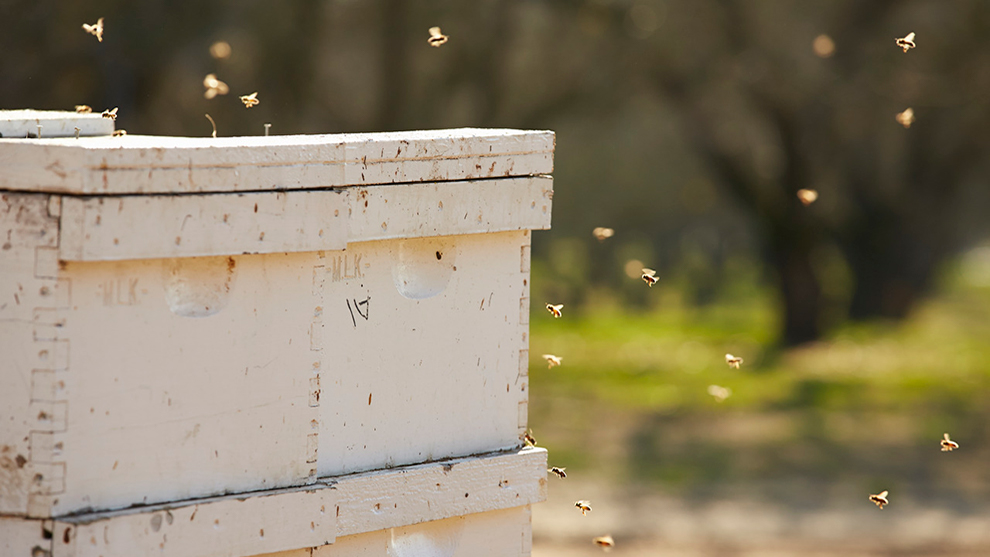
Feb 26, 2021Growers beware: Africanized bees pose risk to European cousins
Africanized bees are an emerging threat to California beekeepers, a situation that has serious and direct implications for almond growers up and down the state.
During bloom, most of the nation’s honeybees come to California as part of a massive joint effort to pollinate an estimated 1.25 million bearing acres of almonds. Some of these honey bee hives originate in Texas, Florida, Louisiana and Georgia – places where Africanized bees are known to have gained a foothold in commercial hives in the past decade.
The risk posed by Africanized bees is not to the almond crop itself. Instead, the threat is to beekeepers, farmworkers and nearby communities. European honeybees have been carefully bred over many decades to ease beekeepers’ ability to work with them to make honey and pollinate crops. Africanized bees, on the other hand, are more aggressive than their more docile European cousins, making them more dangerous for beekeepers and anyone else who may come in contact with them. For this reason, every almond grower has a stake in keeping honeybees from breeding with Africanized bees. More importantly, the Africanized drones’ ability to successfully breed with European virgin queen bees is a long-term issue for California beekeepers.
The threat is especially great in the Northern Sacramento Valley, which is the center of European queen bee breeding activity for much of North America.
“It is the only region in the country where commercial beekeepers can buy queens free of the aggressive Africanized Honey Bee (AHB) traits, found in all other queen breeding territories,” said Ryan Burris, president of the California Bee Breeders Association in a recent letter to members. “Our gentle queen stocks help ensure that beekeepers do not lose their bee locations or pollination contracts, which could happen with hives infected by aggressive AHB traits.”
This issue was brought into sharp focus in 2020 when about 1,200 Africanized colonies from Florida were imported into the Northern Sacramento Valley and placed in close proximity to thousands of European honey bee “mating nucs” – the small boxes that queens are raised in.
Then, at the end of last year’s bloom, an almond grower in the region decided to purchase the Florida hives used to pollinate his crop. It was only later that genomic testing revealed the presence of Africanized drones in the hives, potentially jeopardizing the nearby European honeybee queens. Upon this realization, the hive owner moved the hives in question.
Since then, the California State Beekeepers Association (CSBA), which represents approximately 300 commercial beekeepers in the state, has worked in concert with the California Bee Breeders Association, California county ag commissioners and the California Department of Food and Agriculture to develop a plan to protect Northern California’s prime bee breeding region from Africanized bees.
The so-called Africanized Protection Zone would:
- apply only to land north of Interstate 80,
- require any hives that test positive for Africanized bees to be immediately removed from the region,
- establish an annual “move out” date of March 12 for any hives that come from states with known Africanized bee populations, and
- lead to potential fines for hive owners and mandatory testing of bees left in place after March 12 that have come from known Africanized states.
Jackie Park-Burris, legislative chairwoman of the CSBA, said there are practical things almond growers can do to reduce the risk of Africanized bees infiltrating European honeybee hives. The best method, she said, is to rent bees from areas known to have little-to-no Africanized bees. Growers also should ask beekeepers to place hives in orchards just before bloom and remove them as quickly as possible once bloom is complete.
Park-Burris said there is no difference in the pollinating capability of European honeybees and Africanized bees, and there is little chance non-experts can tell them apart.
“Africanized honeybees do not look different than European honeybees,” she said. “They are slightly smaller, but a person would need to measure them in a lab setting to determine that. The beekeepers working with them do know the difference, however, as they are much more aggressive and they ‘run’ when you work them.”
Park-Burris said that once agitated, Africanized bees will pursue their victim in greater numbers and farther from their hive than European honeybees, increasing their danger not just to almond growers and their employees, but also to the general public. In addition, though they breed in higher numbers, Africanized bees store less honey than their European counterparts.
Chief Scientific Officer for the Almond Board of California Josette Lewis said there are far-reaching implications if Africanized bee numbers increase in the state.
“If Africanized bees mix into the queen bee breeding program centered in Northern California, that will affect bees throughout North America,” she said. “Given that almond growers really rely on beekeepers and the labor they have to hire, it’s in our best interest to keep the queen bee breeding program protected. We recommend that growers, particularly in the Northern Sacramento Valley, ensure that hives are moved by mid-March.”
For more recommendations on best practices during bloom, please visit Almonds.com/Pollination to reference the Almond Board’s Honey Bee Best Management Practices and other resources.







